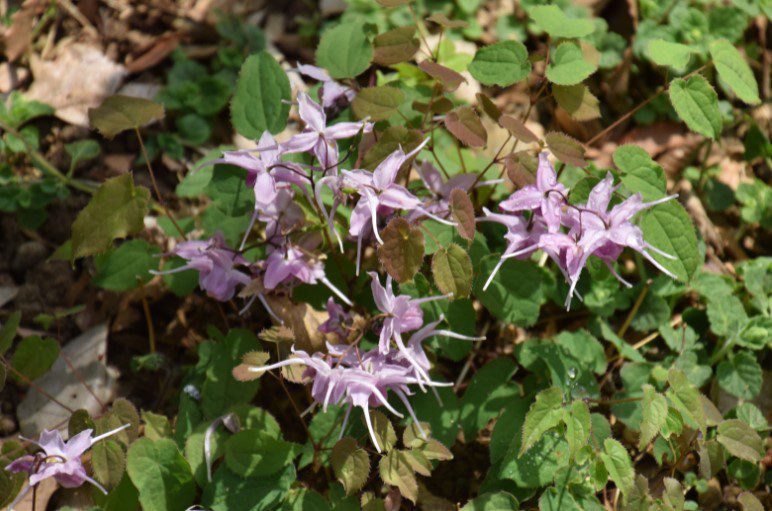Barrenwort Plant Information
Most often used as a ground cover beneath trees, barrenwort also makes a handsome specimen plant in a shady garden. It survives in dry soil. Problems with pests or diseases are almost nonexistent.
Little or no maintenance is needed, and spreading is so slow that plants seldom (if ever) require thinning.
Barrenwort’s dainty flowers look something like tiny columbine blossoms, and I welcome them in spring. But I especially prize the handsome, 8- to 12-inch-tall clumps of heart-shaped leaves that emerge tinged with red in spring, then turn dark green.
Even now, after weeks of cold weather, the bronze-tinged autumn foliage remains a garden asset.
A red-flowered barrenwort (Epimedium x rubrum) was the first one I tried. I considered it the last resort for the steep, shaded slope under the steps of our back deck where previous perennials had failed.
To my surprise, the red barrenwort plants prospered in this sheltered spot, despite receiving little sunlight or water.
Next, I tried a few plants of a yellow-blooming barrenwort called Sulphureum (E. x Versicolor) beneath a silver maple tree. With no care other than a little water during droughts, these plants, too, have thrived and gradually increased, growing more handsome with time.
Impressed with the performance of barrenwort as a ground cover, I realized this well-mannered perennial would also make a great companion for ferns, hostas, and other shade-loving plants.
Young’s barrenwort (E. youngianum) seemed particularly ideal for interplanting with other perennials since it is slightly smaller and slower growing.
I chose two kinds: Niveum, with pure white blossoms, and Roseumm, which has lilac-pink flowers. Hardy to minus 25 or 30 degrees (U.S.D.A. zone 4), barrenwort grows best in fertile, well-drained soil.
Although the plants can survive in dry soil, they do even better with a little more moisture.
Add compost or another organic material to the soil before planting and maintain a layer of shredded bark or other mulch to help preserve soil moisture. Space plants about 12 inches apart.
You can transplant in spring or fall if desired.
Although not necessary for the health of the plants, you can also clip the foliage to the ground in spring for an unspoiled view of the emerging leaves and flowers.
How to Grow Barrenwort Plants
These tiny plants are drought-tolerant and resistant to deer. For a faster display in colder climates, you might choose to plant rhizomes indoors. A clump can be divided in spring, before the plant’s flower, or in autumn.
The soil required to grow barrenwort is acidic with lots of organic amendments. Plants require regular water to establish, but they can tolerate low water conditions once they mature.
Once mature, the plant is prolific, and you can easily harvest rhizomes for other areas or give them to gardening friends.
Care and Maintenance of Barrenwort Plants
Now that you know how to grow them, it’s time to learn more about their care and maintenance. Although barrenwort flowers usually die back in winter, some species, like red and bicolor, can be kept green year-round.
They can be encouraged to grow new colors by being sheared in the winter, but this is unnecessary. Vine weevils are the only serious pest.
Mosaic virus, which can be a problem, should also be removed. Barrenwort requires very little care and only occasional watering and division once in a while.
These tiny, lively plants measure 6 inches (15 cm). These tall plants are wonderful for their delicate foliage and tiny flowers.
Barrenwort Use
Barrenwort is an excellent ground cover for shady areas, especially where there are trees.
It is tolerant of heavy shade and dry soil conditions that are common under forest conditions. The mound-forming plants will naturalize over a period of years.
General culture: Areas with shade and moist, well-drained soil that has a lot of organic matter is ideal.
Severe winters may cause foliage injury. In the spring, prune any injured foliage back to near ground level and fertilizer. The plants are basically pest-free.


























